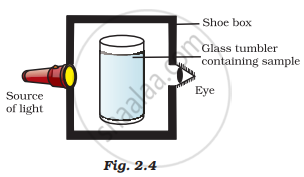Advertisements
Advertisements
Question
Explain the following giving an example.
Saturated solution
Solution
- A saturated solution is a solution in which the maximum amount of solute has been dissolved at a given temperature. The solution cannot dissolve beyond that amount of solute at that temperature. Any more solute added will settle down at the bottom of the container as a precipitate.
- Suppose 500 g of a solvent can dissolve a maximum of 150 g of a particular solute at 40°C. Then, the solution obtained by dissolving 150 g of that solute in 500 g of that solvent at 300 K is said to be a saturated solution at 300 K.
APPEARS IN
RELATED QUESTIONS
Pragya tested the solubility of three different substances at different temperatures and collected the data as given below (results are given in the following table, as grams of substance dissolved in 100 grams of water to form a saturated solution).
| Substance dissolved | Temperature in K | ||||
| 283 | 293 | 313 | 333 | 353 | |
| Solubility | |||||
| Potassium nitrate | 21 | 32 | 62 | 106 | 167 |
| Sodium chloride | 36 | 36 | 36 | 37 | 37 |
| Potassium chloride | 35 | 35 | 40 | 46 | 54 |
| Ammonium chloride | 24 | 37 | 41 | 55 | 66 |
- What mass of potassium nitrate would be needed to produce a saturated solution of potassium nitrate in 50 grams of water at 313 K?
- Pragya makes a saturated solution of potassium chloride in water at 353 K and leaves the solution to cool at room temperature. What would she observe as the solution cools? Explain.
- Find the solubility of each salt at 293 K. What salt has the highest solubility at this temperature?
- What is the effect of change of temperature on the solubility of a salt?
Identify the solutions among the following mixtures.
- Soil
- Sea water
- Air
- Coal
- Soda water
Give an example of gas in a liquid.
Give an example of a solid in a liquid.
Smoke and fog both are aerosols. In what way are they different?
Name the process associated with the following
A potassium permanganate crystal is in a beaker and water is poured into the beaker with stirring.
A solution is always a liquid. Comment.
Can a solution be heterogeneous?
A group of students took an old shoebox and covered it with black paper from all sides. They fixed a source of light (a torch) at one end of the box by making a hole in it and making another hole on the other side to view the light. They placed a milk sample contained in a beaker/tumbler in the box as shown in Fig.2.4. They were amazed to see that milk taken in the tumbler was illuminated. They tried the same activity by taking a salt solution but found that light simply passed through it?
(a) Explain why the milk sample was illuminated. Name the phenomenon involved.
(b) The same results were not observed with a salt solution. Explain.
(c) Can you suggest two more solutions that would show the same effect as shown by the milk solution?

What is the solvent?
